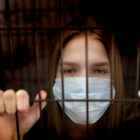
California’s Closure of DJJ Is Victory With Significant Challenges
|
California Gov. Gavin Newsom announced the closure of the state’s youth justice system, the Division of Juvenile Justice (DJJ), with the release of his revised state budget...
Juvenile Justice Information Exchange (https://jjie.org/category/ideas-and-opinions/page/13/)

California Gov. Gavin Newsom announced the closure of the state’s youth justice system, the Division of Juvenile Justice (DJJ), with the release of his revised state budget...

As of April 8, Chicago’s Cook County Jail was the top cluster for the virus that causes COVID-19 in the U.S. As of today, it’s the Marion Correctional Institution in Marion, Ohio, according to data compiled by the New York Times.

Though it’s been 12 years since I visited, an image from a juvenile confinement facility in Alabama remains vivid in my mind’s eye: a simple wall, visible from a glass control room, separating two identical wings of small concrete cells.

As the COVID-19 pandemic explodes into a full-blown public health and economic crisis, states around the country are beginning to recognize that now is not the time to assess and collect fees and fines in the criminal legal system. These emergency reforms are win-win: Families keep the money they need for daily survival, and criminal courts free up their time and attention to concentrate on more pressing issues.

In 2016, my colleagues and I wrote a paper that examined risk factors for repeat violent injury among black men in Baltimore that was published in the Journal of Surgical Research. The data we used for our analysis was collected from a questionnaire about risk factors for repeat violent injury.

From Louisiana to New York, juvenile detention centers are reporting more staff and children testing positive for COVID-19. Incarcerated youth are extremely vulnerable to infection. We know these numbers will only continue to get worse unless youth justice systems act immediately. Releasing youth from locked facilities where social distancing is impossible or avoiding sending them there in the first place is critical. This is why even those of us who have experience running such facilities are calling for action.

Across the world, we are all racing to save the most vulnerable in our societies from the devastation of the COVID-19 pandemic. In the United States, however, we are leaving some of our children trapped with nowhere to turn, nowhere to run.

(This column is dedicated to the memory of Paul DeMuro, who passed earlier this week from a non-COVID-19 related illness. Paul was a longtime leader and mentor to so many in the work to reduce incarceration and improve the lives of young people and families in the justice system.)
On April 1, Kenneth Moore, a youth development representative at Washington, D.C.’s juvenile justice agency died of COVID-19. Kenneth was the first correctional officer in the nation to succumb to the virus. Today, many more staff and youth inside correctional facilities are sick and dying. I had the privilege of helping lead the District’s juvenile justice agency, the Department of Youth Rehabilitation Services (DYRS), between 2005 and 2010.

Over the course of the COVID-19 crisis, we’ve heard a lot about curves. Graphs show terrifying projections of how infection rates will spike and strain our health care system if we don’t take dramatic steps to slow the virus’ spread.

The massive, 82% plummet in youth arrests over the last quarter-century has devastated California’s youth correctional system, the Division of Juvenile Justice (DJJ).